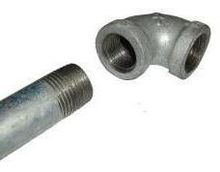- National pipe thread
-
National Pipe Thread Tapered Thread (NPT) is a U.S. standard for tapered threads used on threaded pipes and fittings. The taper rate for all NPT threads is 1⁄16 (3⁄4 inch per foot) measured by the change of diameter (of the pipe thread) over distance. The angle between the taper and the center axis of the pipe is 1° 47′ 24″ (1.7899°). Commonly-used sizes are 1⁄8, 1⁄4, 3⁄8, 1⁄2, 3⁄4, 1, 1 1⁄4, 1 1⁄2, and 2 inch, appearing on pipes and fittings by most U.S. suppliers. Sizes smaller than 1⁄8 are occasionally used for compressed air, while sizes larger than 2 in are uncommon, due to the use of alternative methods of joining that are used with these larger sizes. NPT is defined by ANSI/ASME standard B1.20.1.[1]
Nominal Pipe Size is loosely related to the inside diameter of Schedule 40 pipe. Because of the pipe wall thickness, the actual diameter of the threads is larger than the NPS, considerably so for small NPS. Other schedules of pipe have different wall thickness but the OD (outer diameter) and thread profile remain the same, so the inside diameter of the pipe is therefore different from the nominal diameter.
Threaded pipes can provide an effective seal for pipes transporting liquids, gases, steam, and hydraulic fluid. These threads are now used in materials other than steel and brass, including PTFE,[2] PVC, nylon, bronze and cast iron.
The taper on NPT threads allows them to form a seal when torqued as the flanks of the threads compress against each other, as opposed to parallel/straight thread fittings or compression fittings in which the threads merely hold the pieces together and do not provide the seal. However, a clearance remains between the crests and roots of the threads, resulting in a leakage around this spiral. This means that NPT fittings must be made leak free with the aid of thread seal tape or a thread sealant compound. (The use of tape or sealant will also help to limit corrosion on the threads, which otherwise can make future disassembly nearly impossible.)
There is also a semi-compatible variant called National Pipe Taper Fuel (NPTF) also called Dryseal American National Standard Taper Pipe Thread, defined by ANSI B1.20.3, designed to provide a more leak-free seal without the use of teflon tape or other sealant compound. NPTF threads are the same basic shape but with crest and root heights adjusted for an interference fit, eliminating the spiral leakage path.
Sometimes NPT threads are referred to as MPT ('Male Pipe Thread'), MNPT, or NPT(M) for male (external) threads; and FPT ('Female Pipe Thread'), FNPT, or NPT(F) for female (internal) threads. An equivalent designation is MIP (Male iron pipe) and FIP (Female iron pipe). Also the terms NPS and NPSM are sometimes used to designate a straight, not tapered, thread. (this should not be confused with NPS meaning Nominal Pipe Size)
Contents
Pipe thread sizes
Nominal pipe size (in) Pipe outer diameter Threads per inch Thread pitch 1⁄16 0.3125 in (7.94 mm) 27 0.03704 in (0.94082 mm) 1⁄8 0.405 in (10.29 mm) 27 0.03704 in (0.94082 mm) 1⁄4 0.540 in (13.72 mm) 18 0.05556 in (1.41122 mm) 3⁄8 0.675 in (17.15 mm) 18 0.05556 in (1.41122 mm) 1⁄2 0.840 in (21.34 mm) 14 0.07143 in (1.81432 mm) 3⁄4 1.050 in (26.67 mm) 14 0.07143 in (1.81432 mm) 1 1.315 in (33.40 mm) 11 1⁄2 0.08696 in (2.20878 mm) 1 1⁄4 1.660 in (42.16 mm) 11 1⁄2 0.08696 in (2.20878 mm) 1 1⁄2 1.900 in (48.26 mm) 11 1⁄2 0.08696 in (2.20878 mm) 2 2.375 in (60.33 mm) 11 1⁄2 0.08696 in (2.20878 mm) 2 1⁄2 2.875 in (73.03 mm) 8 0.12500 in (3.175 mm) 3 3.500 in (88.90 mm) 8 0.12500 in (3.175 mm) 4 4.500 in (114.30 mm) 8 0.12500 in (3.175 mm) 5 5.563 in (141.30 mm) 8 0.12500 in (3.175 mm) 6 6.625 in (168.28 mm) 8 0.12500 in (3.175 mm) 10 10.750 in (273.05 mm) 8 0.12500 in (3.175 mm) 12 12.750 in (323.85 mm) 8 0.12500 in (3.175 mm) 14 14 in (355.60 mm) 8 0.12500 in (3.175 mm) 16 16 in (406.40 mm) 8 0.12500 in (3.175 mm) 18 18 in (457.20 mm) 8 0.12500 in (3.175 mm) 20 20 in (508.00 mm) 8 0.12500 in (3.175 mm) 24 24 in (609.60 mm) 8 0.12500 in (3.175 mm) Thread form
NPT and NPS threads have a 60° included angle and have a Sellers thread form (flattened peaks and valleys).
Terminology
Sometimes these terms may be used:
- MIP: stands for Male Iron Pipe, or Male International Pipe, or MPT Male Pipe Thread. It is a term for pipe fittings.
- FIP: stands for Female Iron Pipe, or Female International Pipe, or FPT. It is a term for pipe fittings that MIP fittings fit into.
The difference between FIP, MIP and Compression fittings is in the tapering of the thread. FIP has taper of 1:16 (6.25% slope), compression has taper of 13:96(13.5% slope).
A female iron connection has a tapered thread, which thins out to the end of the pipe. As the fitting is tightened, the ever-decreasing thread depth means that the connection becomes watertight. To properly seal the fitting, paste thread sealant or PTFE (polytetrafluoroethylene) tape wrapped around the thread is required.
MIP fittings are usually found in thicker copper pipe, iron pipe, steel pipe, gas pipe, gas stove, gas oven, gas heater, and gas water heater connections.
See also
- AN thread
- British standard pipe thread
- Panzergewinde
- Thread angle
- Threaded pipe
References
- ^ http://www.hemcogages.com/ansi.htm
- ^ http://www.micromold.com/threaded_piping.html PTFE threaded pipe and fittings manufacturer
Further reading
Oberg, Erik; Franklin D. Jones, Holbrook L. Horton, and Henry H. Ryffel (2000). ed. Christopher J. McCauley, Riccardo Heald, and Muhammed Iqbal Hussain. ed. Machinery's Handbook (26th edition ed.). New York: Industrial Press Inc.. ISBN 0-8311-2635-3.
External links
http://publicaa.ansi.org/sites/apdl/Documents/Standards%20Action/2011%20PDFs/SAV4220.pdf
Categories:- Mechanical standards
- Piping
- Plumbing
- Threading (manufacturing)
Wikimedia Foundation. 2010.

